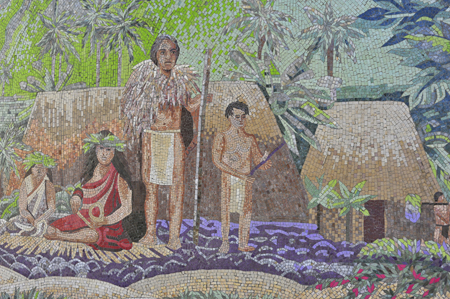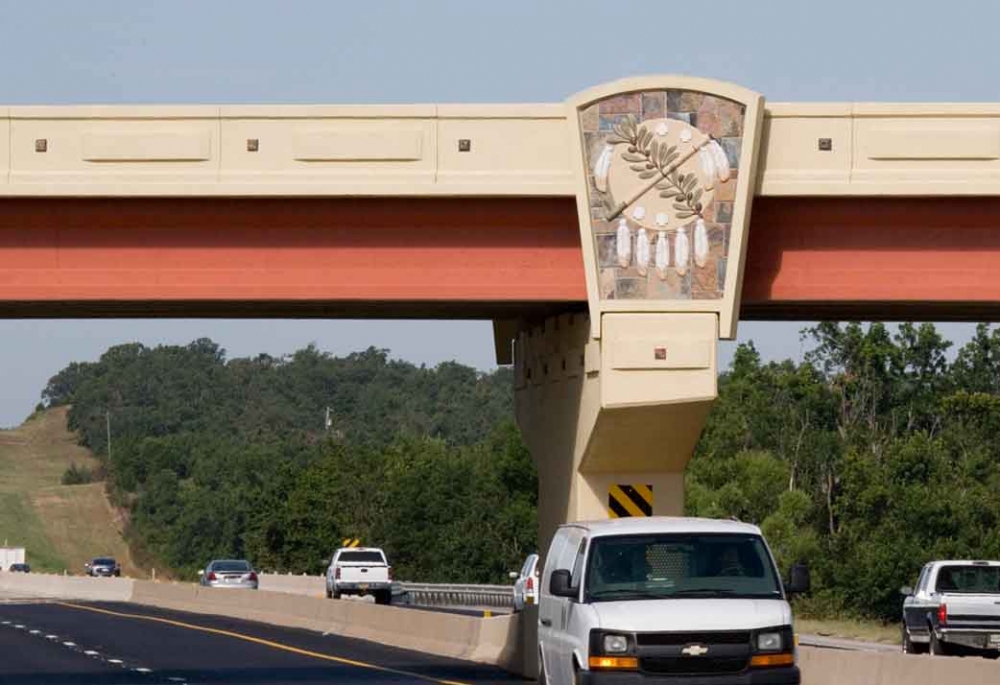April
2013
April 2, 2013
Hawaiʻi, Oklahoma and New Hampshire: Percent for Art Programs
This month’s State to State column features percent for art programs in three states that are indicative of the successes and challenges of state arts agencies in sustaining public art. State percent for art policies designate small amounts from appropriations for state-building capitol improvements be used for public art installations. The amount set aside is typically about 1%. For information on policies and procedures in all 25 states with currently active programs, see the updates NASAA recently posted on State Percent for Art Programs. Contact information for each state also is available.

Stone mosaic at Pomaikaʻi Elementary School, Kahului, Maui, by Philip B. Sabado. Photo courtesy Hawaiʻi State Foundation on Culture and the Arts
In Hawaiʻi, the Art in Public Places—Artists in Residence Program (APP-AIR) combines the installation of public art in schools with artist-led education in the classroom and the studio. The program is run collaboratively by the Hawaiʻi State Foundation on Culture and the Arts (HSFCA) and the state’s Department of Education. Each public art project’s commissioned artist serves as an artist in residence for the school receiving the artwork. Artists in residence engage students and teachers in all phases of the commission, giving them a voice in the project while teaching them about an artwork’s conceptualization, design, production, installation and evaluation. The APP-AIR Program is underwritten by HSFCA’s percent for art program, Works of Art Special Fund. For more information about the APP-AIR Program, contact APP Program Manager Dianne Cripe or Commissions Project Manager Trisha Lagaso Goldberg.

Heritage Bridge, Turner Turnpike and State Highway 102, Lincoln County, by Steven Weitzman, Creative Design Resolutions, Inc. Photo courtesy Oklahoma Arts Council
Oklahoma‘s percent for art program, Art in Public Places (AIPP), was threatened this legislative session by a bill that would have extended an existing program moratorium, currently set to expire in 2014. The bill, H.B. 1430, was introduced in January but died in late March. The Oklahoma Historical Society administers the program in cooperation with the Oklahoma Arts Council (OAC), which authored the program’s original legislation in 2004. One and one-half percent of capital construction costs above $250,000 are allocated for public artwork. Despite antagonists’ claims to the contrary, a state senate fiscal analysis of the program found that elimination of the AIPP program would result in zero net savings for the state due to how capital construction is financed in Oklahoma. In addition to managing the art installations and maintenance, the AIPP program produces interactive teaching tools in Prezi format about works in the state public art collection. These tools, aligned with the state’s core curriculum standards, help students learn about many subjects including art, physics, sociology, math, chemistry, history and environmental studies. For more information, see the program’s fact sheet or contact Art in Public Places Program Director Debby Williams.

Detail of “We the People” by Ingrid Pichler, Hillsborough County Superior Courthouse North, Manchester. Photo courtesy New Hampshire State Council on the Arts
New Hampshire‘s Percent for Art program was recently under legislative threat. A bill considered during the 2012 session, H.B.1285, would have repealed the authorization and funding for the program, which allocates 0.5% of the first $15 million of new or major additions to state buildings funded through the state capitol budget to public art projects for those buildings. The bill was debated vigorously during the session and finally sent to interim study. The interim study report researched states with and without percent for art programs and alternative ways to fund art in public buildings. The report recommended that the Percent for Art program “serves the best interest of the citizens and the State of New Hampshire and should remain in place without change.” As a result, the New Hampshire State Council on the Arts (NHSCA) continues to run the program, which engages planners, architects, state employees, art professionals and private citizens in a collaborative process to commission or purchase works for state buildings. The artworks selected through this collaborative process often complement the missions of the agencies housed within public buildings. For instance, in March, NHSCA completed installation of two hanging sculptures by artist Ingrid Pichler and three tile murals by artist Teresa Taylor in the Hillsborough County Superior Courthouse North in Manchester. The hanging sculptures feature suspended Plexiglas elements formed to symbolize the text of the U.S. Constitution, the Bill of Rights and other fundamental laws. Entitled “We the People,” the sculptures seek to convey that we govern ourselves through mutually agreed upon principles. The tile murals represent the Merrimack River that runs through the heart of Manchester. The river once served as the source of power for the Amoskeag Mills, which in the mid-1800s was one of the largest textile factories in the world, and a site that served as a model of planning and progress. To learn more, contact NHSCA Acting Director Lynn Martin Graton.
In this Issue
State to State
Legislative Update
More Notes from NASAA
Executive Director's Column
Research on Demand
SubscribeSubscribe
×
To receive information regarding updates to our newslettter. Please fill out the form below.
